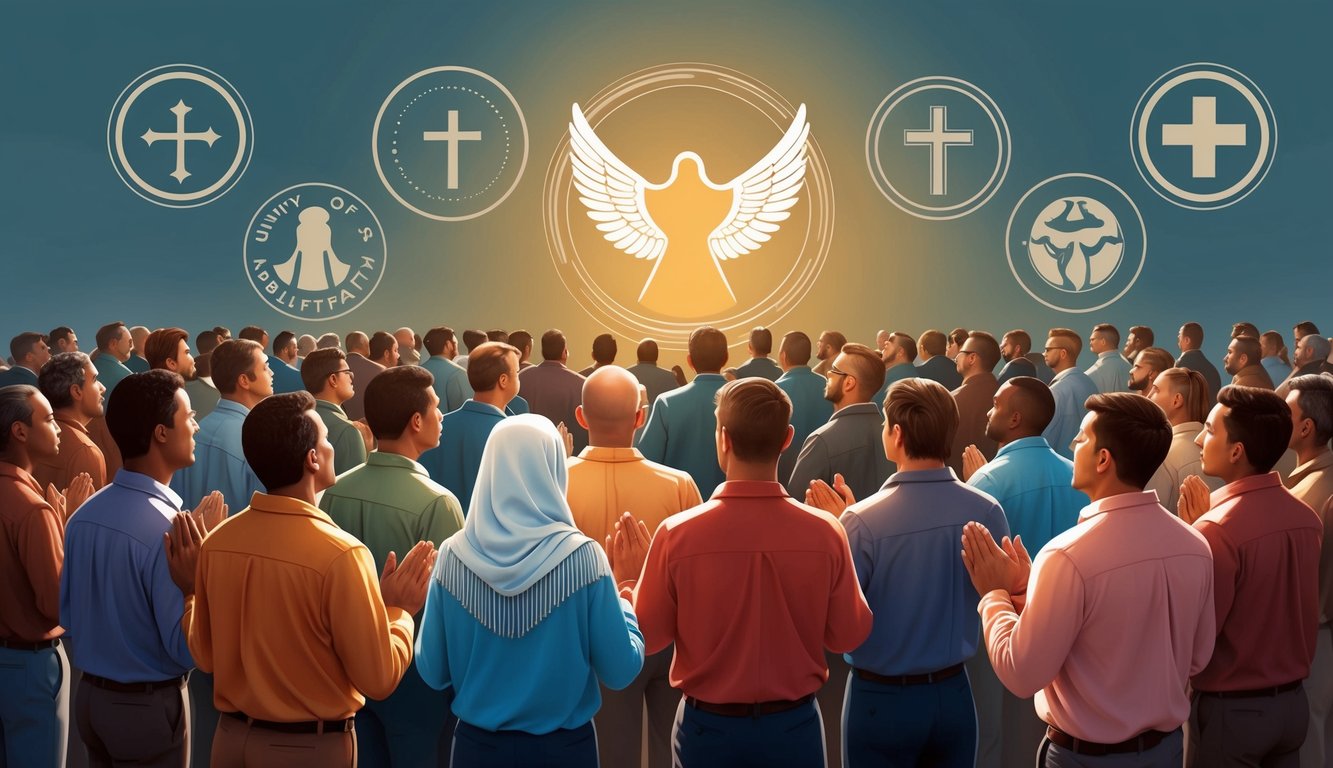Don’t Miss Out On This Unique Astrological Opportunity
Are you tired of spinning your wheels and getting nowhere? Simply put, you’re out of sync: you’re out of alignment with your astral configuration.
But: there’s a kind of map that can help you reclaim your alignment. Think of it as your own personal blueprint to success and happiness: a blueprint that will help you live your most amazing life.
Get started here.
Acts 4 is a compelling chapter in the New Testament that draws you into a world of bold faith and dramatic encounters.
The story unfolds in Jerusalem, where Peter and John, two of Jesus’ apostles, find themselves in trouble for preaching about the resurrection.
Their message irks the religious leaders, leading to their arrest.
Despite the opposition, the apostles stand firm in their belief, showcasing their unwavering dedication to their mission.
After spending a night in custody, Peter and John are brought before the Sanhedrin, the Jewish council.
Here, Peter boldly speaks about Jesus and the power of his resurrection. Even when faced with authority and possible punishment, they do not back down but instead use the opportunity to spread their message. This encounter highlights the courage and conviction of the apostles in the face of adversity.
The chapter also reveals the reaction of the early believers as they unite in prayer and support for Peter and John.
This sense of community underscores the themes of faith and resilience.
The episode not only provides a glimpse into the early church’s struggles but also its strength and unity in adversity.
Key Takeaways
- Peter and John are arrested for preaching about Jesus’ resurrection.
- They boldly defend their faith before the Sanhedrin.
- The believers respond with unity and prayer.
The Arrest of Peter and John
Acts 4 begins with Peter and John getting in trouble for their teachings.
Their teachings stirred up the religious leaders of Jerusalem, leading to their arrest.
Peter and John Address the Onlookers
As Peter and John spoke to the crowd in the Temple, the people gathered around them.
They talked about Jesus and how He had risen from the dead.
Many listeners were amazed, especially after witnessing a lame man being healed.
The number of followers grew, reaching around 5,000 men.
Their words didn’t sit well with everyone, though.
The Priests and Sadducees were upset by their teaching.
They couldn’t understand how such ordinary men spoke with so much power and confidence.
The Captain of the Temple Guard was there, ensuring order among the growing crowd.
The Inquiry by Jerusalem’s Leaders
The following day, the religious leaders came together in Jerusalem.
Annas, a chief priest, led the inquiry.
They questioned Peter and John, wanting to know the source of their boldness.
The leaders were surprised by their courage and how they spoke with authority.
The sight of the healed man standing with them made their claims about Jesus more convincing.
Even though the leaders were hesitant, they couldn’t deny the miracle.
The Priests and Sadducees had a challenging time trying to find fault with these two men.
Their teachings and the miracle left a strong impression on everyone.
Peter and John Before the Sanhedrin

The next part of the chapter focuses on Peter and John’s trial before the Sanhedrin.
Their boldness drew attention, as they defended their actions and spread the message of Jesus Christ.
The Interrogation about the Healed Man
When you learn about Peter and John’s interrogation, you’ll see they were questioned about a healing.
The healed man stood with them, a witness to the miracle.
It’s important to know that the council, including leaders like Annas and Caiaphas, sought answers.
The challenge was acknowledging the man’s healing without supporting the apostles’ message.
Faced with undeniable evidence, the Sanhedrin was baffled.
Their question was simple: By what power or name did they perform this miracle?
The council’s authority was threatened.
Peter and John, known for their boldness, confidently defended their actions.
The Sanhedrin’s attempts to silence them were ineffective, as the miracle stood as a testament to their work.
Proclamation of Jesus Christ
In this situation, you will find that Peter boldly proclaimed the power of Jesus Christ as the source of healing.
This moment was crucial because he emphasized that it was through Jesus, whom they crucified, that the miracle occurred.
Peter’s words demonstrated great courage before a powerful group.
This statement angered the council members, especially since it reminded them of the resurrection.
The apostles faced stern warnings, but they remained unwavering.
Their dedication to spreading Jesus teachings was their top priority.
The high priest and others were unable to counter the apostles’ firm message about Jesus.
Peter and John’s resolve showcased their commitment to their faith and the power they believed in.
The Response of the Believers
When faced with challenges, the believers in Acts 4 showed unity and determination.
They prayed together for courage, witnessed signs and wonders, and shared their resources with one another.
Prayer for Boldness
In Acts 4, when the believers faced threats, they gathered to pray for boldness.
They asked God to help them speak His word with courage.
This prayer was a powerful moment of unity.
It showed their reliance on the Holy Spirit to guide and strengthen them.
Their hearts were united in this request.
Instead of praying for safety, they sought the boldness to continue their mission.
Through this prayer, they demonstrated a deep trust in God’s grace.
Signs and Wonders among the People
After the prayer, the place where they gathered shook, and they were filled with the Holy Spirit.
This was a sign of God’s presence among them.
The believers began to speak about God with never-before-seen boldness.
Miracles and wonders followed them as they spread the message.
These events were evidence of the Holy Spirit working through them.
The believers saw these signs as confirmations of their faith.
Sharing among the Believers
The early church showed a strong sense of community by sharing their possessions.
Believers, including figures like Barnabas, sold their property to support those in need.
This sharing was an expression of their love and unity.
Their common goal was to ensure no one among them lacked anything.
With one heart and one soul, they willingly gave and helped each other.
The community’s actions reflected their shared grace and strong bond.
Key Themes and Theological Points

Acts 4 presents several important themes that highlight the power and significance of Jesus’ name, the unique nature of salvation through Him, and the essential role of faith in the life of believers.
Each of these elements contributes to a deeper understanding of Christian theology.
The Name of Jesus
In Acts 4, the name of Jesus is central to the events and teachings.
You see the apostles emphasizing the power of Jesus’ name in performing miracles and preaching.
This highlights Jesus as the cornerstone of faith, where His name carries authority and divine presence.
It’s not merely a label but embodies His identity and mission.
When Peter and John heal a man, they do so in the name of Jesus Christ, showing its transformative power.
Emphasizing His name underscores His role as the only one through whom believers can access divine intervention.
This teaches you the importance of recognizing and invoking Jesus’ name in acts of faith and devotion.
Salvation through Christ Alone
A key message in Acts 4 is that salvation is found in Christ alone.
The apostle Peter boldly states that no other name under heaven offers salvation to humankind.
This exclusivity highlights the unique role of Jesus in God’s redemptive plan.
This proclamation emphasizes the necessity of faith in Jesus for eternal life, reinforcing the central Christian belief in His role as the sole Savior.
The urgency of this message aligns with the Matthew 25 parables, which illustrate the importance of preparedness and faithful service in anticipation of God’s judgment.
Just as those parables warn of the consequences of neglecting God’s call, Acts 4 urges unwavering trust in Christ for salvation.
Belief in Him as the cornerstone ensures a secure spiritual foundation.
Salvation is not through your works or status but through faith in Jesus.
Acts 4 reminds you that trusting in Jesus Christ is essential for salvation, affirming that His death and resurrection provide the path to eternal life.
This belief fosters unity among believers who share this faith.
The Role of Faith
Faith plays a significant part in the narrative of Acts 4.
The apostles’ boldness comes from their unwavering faith in Jesus, despite facing opposition from religious leaders.
Faith is portrayed as an enabler, allowing Peter and John to speak the Word of God powerfully and confidently.
Their faith acts as a witness to the resurrection of the dead, showing its truth and urgency.
This narrative encourages you to stand firm in your beliefs.
It illustrates how faith empowers you to overcome trials and proclaim the Word of God with boldness.
Through faith, you become a servant of His message, helping to spread the gospel.
Frequently Asked Questions

In Acts Chapter 4, you see Peter and John demonstrate boldness in their faith.
The chapter highlights the community of believers, their prayers, and their challenges with authorities.
These events contribute to the early church‘s development.
Who were the main characters in Acts Chapter 4?
The main characters in Acts Chapter 4 are Peter and John.
They are two of Jesus’ apostles who boldly preach about Jesus and heal a man.
The chapter also involves the Sanhedrin, a group of Jewish leaders who opposed them.
How does Peter’s speech in Acts 4 relate to the overall message of the Gospel?
Peter’s speech centers on the power and resurrection of Jesus, conveying a core message of the Gospel.
He firmly asserts that salvation is found only in Jesus.
This reflects the central Christian belief in Jesus as Savior.
What is the significance of the prayer of the believers in Acts 4:23-31?
In Acts 4:23-31, believers pray together for boldness.
Their prayer emphasizes trust in God’s power and asks for courage to continue sharing the Gospel despite opposition.
This moment highlights the importance of prayer for strength and unity.
How is the theme of community depicted in Acts 4?
The community in Acts 4 is characterized by unity and sharing.
Believers are described as being of one heart and soul, sharing their possessions to ensure no one lacks anything.
This illustrates selflessness and support among the early Christians.
In what way did the events of Acts Chapter 4 set the stage for the early Christian church?
Acts 4 shows the apostles’ unwavering faith in Jesus despite trials.
Their boldness and the community’s unity set a foundation for the growth of the church.
The determination to spread the Gospel influenced the strength and expansion of early Christianity.
What are the implications of the apostles’ trial before the Sanhedrin in Acts 4?
The trial before the Sanhedrin reveals the tension between early Christians and Jewish leaders.
The apostles’ testimony and refusal to stop preaching highlight their commitment to their faith.
This confrontation signaled the beginning of ongoing challenges for the church but also affirmed its resolve.



